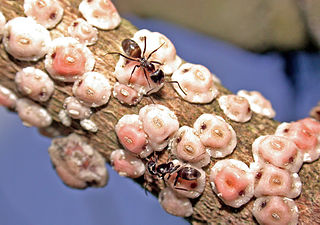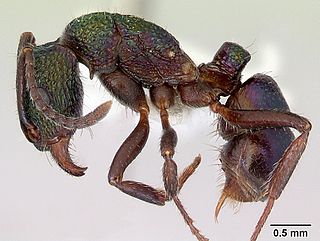
Myrmecology is a branch of entomology focusing on the scientific study of ants. Some early myrmecologists considered ant society as the ideal form of society and sought to find solutions to human problems by studying them. Ants continue to be a model of choice for the study of questions on the evolution of social systems because of their complex and varied forms of eusociality. Their diversity and prominence in ecosystems also has made them important components in the study of biodiversity and conservation. Recently, ant colonies are also studied and modeled for their relevance in machine learning, complex interactive networks, stochasticity of encounter and interaction networks, parallel computing, and other computing fields.

The kinkajou is a tropical rainforest mammal of the family Procyonidae related to olingos, coatis, raccoons, and the ringtail and cacomistle. It is the only member of the genus Potos and is also known as the "honey bear". Kinkajous are arboreal, a lifestyle they evolved independently; they are not closely related to any other tree-dwelling mammal group.

Dolichoderinae is a subfamily of ants, which includes species such as the Argentine ant, the erratic ant, the odorous house ant, and the cone ant. The subfamily presents a great diversity of species throughout the world, distributed in different biogeographic regions, from the Palearctic, Nearctic, Afrotropical region and Malaysia, to the Middle East, Australian, and Neotropical regions.

Dorymyrmex is a genus of ants in the subfamily Dolichoderinae.

Lasius umbratus is a parasitic ant. The queens of this species seek out a Lasius niger worker ant, to first kill in order to gain the worker ant's scent and then to discreetly sneak inside a Lasius niger nest. Once inside the Lasius umbratus queen finds the Lasius niger queen, and kills her. The worker ants will care for the new queen's larvae and slowly the colony will become one of Lasius umbratus. 'Umbratus' is Latin for the word 'ghost'.

Antennophorus is a genus of mites in the family Antennophoridae. It was described by Haller in 1877.

Rhytidoponera is a large genus of ants in the subfamily Ectatomminae. The genus is known from Australia and Melanesia, with New Caledonia as the most eastern limit.

Meranoplus is an Old World genus of ants in the subfamily Myrmicinae. With over 80 valid species, it is predicted that over half of the Meranoplus diversity remains undescribed, most of these from Australia.

Myrmecia nigrocincta, commonly known as the jumper ant or jumping jack, is an ant of the genus Myrmecia. The species was first described by Frederick Smith in 1858. Colonies of this ant are abundant in eastern Australia. Ants of this species are known for their ability to jump up to 10 centimetres, and they also have a powerful, venomous sting. Rather than foraging on the ground, M. nigrocincta prefer to forage in trees where they are known to pollinate certain flowers.
Myrmecia ludlowi is an Australian ant which belongs to the genus Myrmecia. This species is native to Australia and is commonly distributed in Western Australia. They were first described by Crawley in 1922.

Myrmecia auriventris is an Australian ant which belongs to the genus Myrmecia. This species is native to Australia and is commonly distributed in Queensland.
Myrmecia clarki is an Australian ant which belongs to the genus Myrmecia. This species is native to Australia and is commonly distributed in Western Australia.

Myrmecia regularis is a species of ant endemic to Australia. A member of the genus Myrmecia in the subfamily Myrmeciinae, it was first described by American entomologist Walter Cecil Crawley in 1925. These ants are medium to large in size, measuring 10 to 20 millimetres, and they are bright brownish-red in colour. Queens and workers share similar morphological features, but they can be distinguished by the noticeable size difference. Males also look similar, but collected specimens are too damaged to be examined properly.
Myrmecia swalei is an Australian ant which belongs to the genus Myrmecia. This species is native to Australia and is commonly distributed in Western Australia and South Australia. It was described by Crawley in 1922.
Arnoldius scissor is a species of ant, one of three species described in the genus Arnoldius. Native to Australia, it was described by Crawley in 1922.
Papyrius flavus is a species of ant in the genus Papyrius. Endemic to Australia, it was described by Mayr in 1865.
Dolichoderus niger is a species of ant in the genus Dolichoderus. Described by Crawley in 1922, the species is endemic to Australia, and can be seen in scrub like habitats in Western Australia, and has been observed in native woodland around the city of Perth.

Dorymyrmex flavus is a species of ant in the genus Dorymyrmex. Described by McCook in 1879, the species is endemic to the United States and Mexico.















